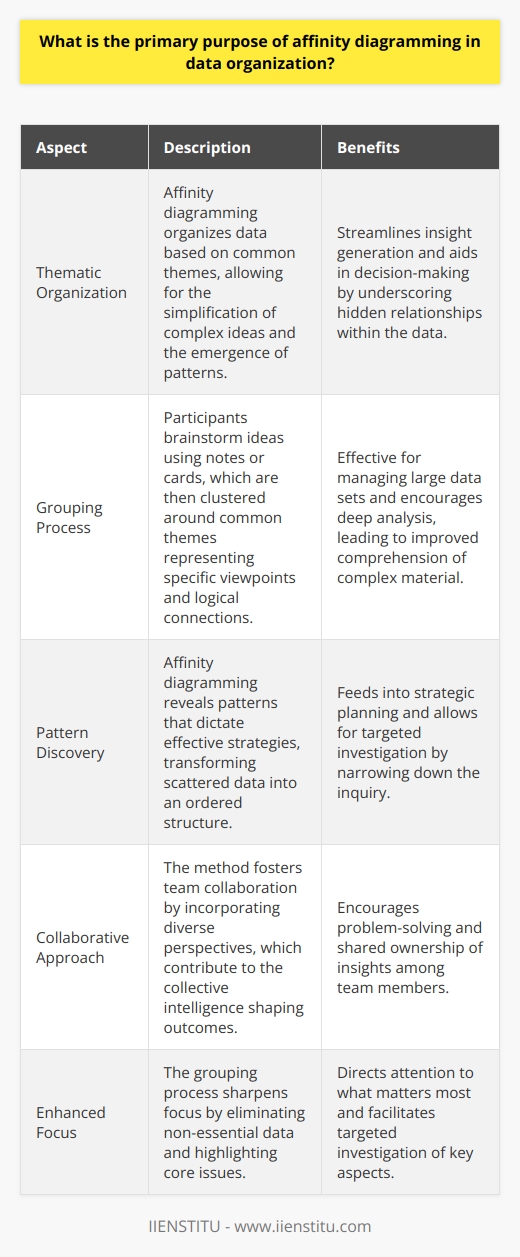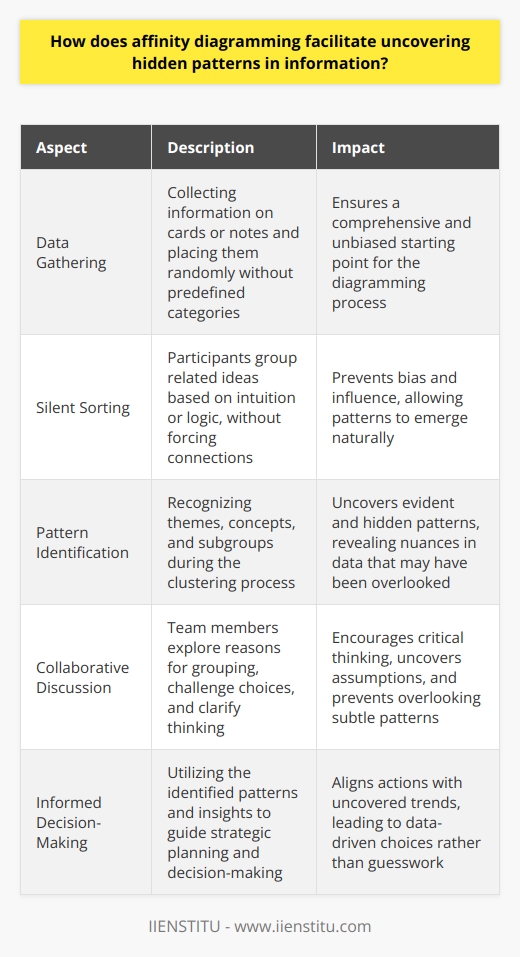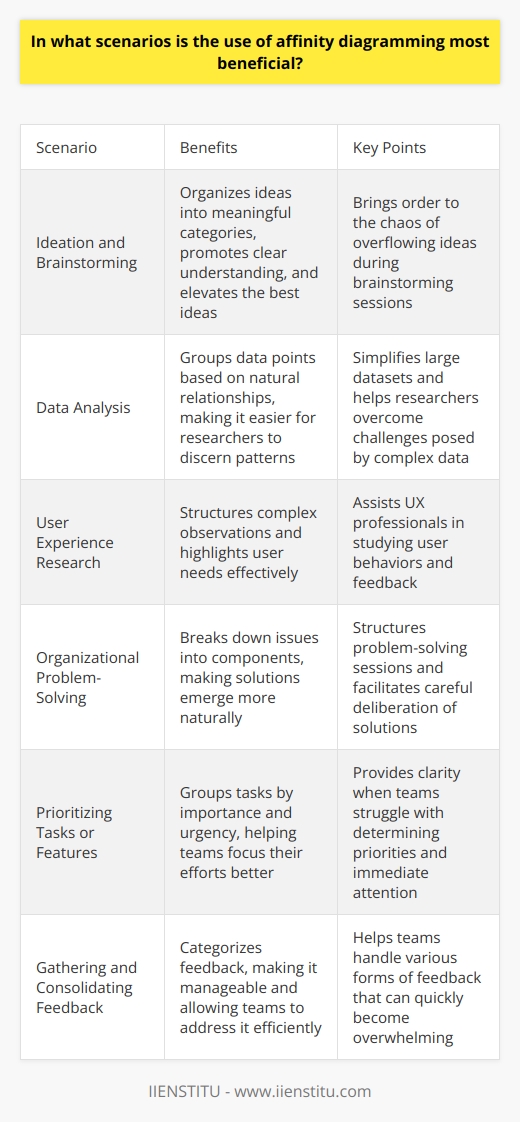
In the realms of data analysis and problem-solving, a harmonious fusion of creativity and analytical rigor is indispensable. Affinity Diagramming serves as a beacon in this complex interplay, offering a structured yet flexible approach to unearthing concealed connections within a plethora of information. Predominantly used within collaborative environments, this technique excels in clustering data and ideas to reveal underlying patterns that often elude conventional analytical methods.
This blog post aims to articulate not only the fundamental concepts of affinity diagramming but also to expound on its practical applications in various domains. Through this exploration, readers will garner a comprehensive understanding of how affinity diagramming catalyzes the process of pattern recognition, thereby magnifying the efficacy of data analysis and problem-solving strategies.
Understanding Affinity Diagramming
Definition and Origin of Affinity Diagramming
Affinity diagramming is a methodological tool designed to organize data, ideas, and insights by grouping them based on their natural relationships. The approach is a mainstay in Knowledge Management and has origins anchored in the quality management field, attributed largely to the work of Jiro Kawakita in the 1960s, which is why it is sometimes referred to as the KJ method.
In its essence, affinity diagramming operates as both a convergence and divergence tool, allowing teams to cast a wide net over their collective knowledge before synthesizing it into coherent groupings that expose previously hidden patterns.
How Affinity Diagramming Fits within Brainstorming Techniques
Brainstorming techniques are often leveraged to foster creativity and generate a multitude of ideas within a group. Affinity diagramming dovetails with these brainstorming exercises by providing a subsequent phase where the abundance of generated ideas can be sifted and sorted. It transcends the typical brainstorming session, guiding the transition from chaotic ideation to structured analysis.
It also complements other brainstorming techniques by imparting a level of discipline and enabling a sense of progression towards a more granular understanding of the problem or topic at hand.
The Role of Affinity Diagramming in Collaborative Environments
The collaborative strength of affinity diagramming comes from its inclusive nature; it encourages the participation of all members within a team, thereby leveraging the diverse perspectives and expertise at play. When employed correctly, it fosters a democratized environment where every idea receives consideration.
Additionally, the visual nature of an affinity diagram acts as a catalyst for communication, making complex relationships between ideas easier to comprehend and discuss among participants, thereby streamlining the collaborative problem-solving process.
The Process of Affinity Diagramming
Step-by-Step Guide to Creating an Affinity Diagram
The practical application of affinity diagramming unfolds in a series of orchestrated steps that transform a constellation of ideas and data into a discernible structure. The initial phase involves the uninhibited gathering and recording of ideas and data points, often done with tools as simple as sticky notes or index cards.
Following this, participants engage in a meticulous search for correlations and themes, scouting for patterns that bind the discrete points together. The culmination of the process is the strategic organizing of data into coherent groups, each labeled with a header that succinctly captures the essence of its content, laying a foundation for further analysis.
Gathering and recording ideas and data points
Searching for correlations and themes
Organizing data into groups
Tools and Resources Needed for Effective Affinity Diagramming
While the beauty of affinity diagramming lies in its low-tech approach, there are specific tools and resources that can enhance the experience. Alongside the basic materials such as sticky notes, markers, and a large working surface, digital solutions like collaborative online whiteboards can be instrumental, especially when dealing with remote teams.
These digital platforms offer features that replicate the physical experience and provide additional conveniences, such as templates, real-time collaboration, and the ability to save and share work effortlessly.
Tips for Leading an Affinity Diagramming Session
Directing an affinity diagramming session demands a careful balance between guidance and freedom. As a leader, it is crucial to ensure that the process stays focused and on track, while also fostering an atmosphere where every voice is heard. Establish clear objectives for the session, provide a brief on the procedure, and encourage participation through open-ended questions and prompts.
Effective facilitation involves active listening and probing for depth, which stimulates the revelation of more profound insights. Finally, remain attentive to group dynamics, providing scaffolding for ideas to connect, ensuring the participation remains vibrant and equitable.
Affinity Diagramming in Action: Real-world Examples
Case Study: Utilizing Affinity Diagramming in a Corporate Setting
In the corporate sphere, affinity diagramming can serve as a potent tool for product development, market research, and organizational improvement. One case study involves a multinational company that faced a stagnation in innovation.
By implementing affinity diagramming sessions during their brainstorming retreats, the company was able to distill the knowledge and insights of its diverse workforce, leading to the development of groundbreaking product concepts that resonated with emerging market trends.
The structured yet flexible nature of the diagramming process made it possible to explore lateral connections between customer needs, technological possibilities, and business objectives.
Example: How Educators Can Use Affinity Diagramming for Curriculum Development
The design of educational curricula can significantly benefit from the application of affinity diagramming. As an illustrative example, educators can collect insights from various pedagogical approaches and academic research, then employ affinity diagramming to synthesize these into a cohesive curriculum framework.
By discerning patterns among learning outcomes, teaching methods, and student feedback, educators can create curricula that are not only comprehensive but also aligned with the aspirations of contemporary education standards, ultimately enhancing the learning experience.
Analysis of a Scenario Where Affinity Diagramming Led to Breakthrough Insights
Affinity diagramming's capacity to reveal breakthrough insights was demonstrated when a healthcare provider utilized it to tackle inefficiencies in patient care. Through a series of affinity diagramming workshops, frontline medical staff, administrators, and patients contributed their experiences and suggestions.
The clustering of this data shed light on systemic issues and presented opportunities for innovation in patient care pathways. This result was not just incremental improvements but rather transformative changes that bettered patient outcomes and streamlined operations, illustrating the profound impact that affinity diagramming can have when employed diligently.
Pattern Recognition and Data Analysis through Affinity Diagramming
Unveiling Hidden Patterns Using Affinity Diagrams
One of the principal strengths of affinity diagramming lies in its uncanny ability to surface hidden patterns within seemingly disparate data points. Patterns that might escape the linear scrutiny of traditional analysis methods become apparent when subjected to the holistic view provided by an affinity diagram. It is this uncovering of the covert structure that fuels advances in understanding and generates the insights necessary for informed decision-making, marking the technique as indispensable in the toolkit of modern data analysts.
Enhancing Problem Solving with Pattern Recognition
The intricate process of problem solving often necessitates the identification of underlying causes and systemic relationships. Pattern recognition, facilitated by affinity diagramming, enables problem solvers to transcend surface-level symptoms and address the root causes of issues. This deeper level of insight leads to more sustainable solutions and innovative approaches to long-standing problems. In fields ranging from business to public health, the enhanced problem-solving capabilities endowed by pattern recognition represent a significant leap forward in tackling complex challenges.
Integrating Affinity Diagramming with Other Data Analysis Techniques
While affinity diagramming stands as a powerful methodology on its own, its true potential is magnified when it is integrated with other data analysis techniques. By informing subsequent quantitative analysis or complementing qualitative methods such as thematic analysis, affinity diagramming acts as the connective tissue that enriches the overall analytical framework. For instance, insights derived from an affinity diagram may guide the construction of more effective surveys or focus group discussions, leading to a more holistic and robust analysis.
Overcoming Challenges in Affinity Diagramming
Common Pitfalls to Avoid in the Affinity Diagramming Process
While the benefits of affinity diagramming are manifold, practitioners must be vigilant against common pitfalls that can compromise its effectiveness. These include the temptation to rush the clustering process, leading to superficial groupings, or allowing dominant personalities to steer the direction of the session, which can result in echo chambers rather than genuine insight. Maintaining an open and iterative approach, being willing to continuously refine and challenge the groupings, and ensuring that all voices are heard are all essential to the integrity of the process.
Strategies for Dealing with Complex or Overwhelming Data Sets
The challenge of handling complex or overwhelming data sets can be mitigated through strategic segmentation of the affinity diagramming process. It may be beneficial to break the data down into more manageable subsets and tackle each in isolation before attempting to form a composite picture. Employing a multi-tiered approach, where broad categories are refined into more detailed sub-categories can also provide clarity. Additionally, leveraging digital tools that facilitate the manipulation and visualization of large data sets can be invaluable.
How to Ensure Participation and Unbiased Results
Ensuring wide participation and guarding against bias are crucial to the success of an affinity diagramming session. Clear framing of the objective, establishing ground rules for equal participation, and as necessary, anonymizing contributions can foster an environment where diverse perspectives thrive.
Utilizing an independent facilitator can also help to curb the influence of bias and maintain neutrality throughout the process. Ultimately, a deliberate and conscious approach to inclusivity and objectivity will result in outcomes that are both legitimate and actionable.
Recap of the Benefits and Utility of Affinity Diagramming in Various Fields
Affinity diagramming transcends disciplinary boundaries, acting as a universal compass for navigating through data and ideas to arrive at actionable insights. It brings to light the latent patterns and connections that often go unnoticed, offering a pragmatic pathway to innovative solutions. Whether in corporate strategy, educational design, healthcare management, or any other field, the utility of this versatile tool is evidentiary in enhancing problem-solving competencies and data analysis capabilities.
Encouragement to Implement Affinity Diagramming in Problem-Solving Endeavors
Professionals and organizations embarking on new challenges or seeking to improve existing processes are encouraged to consider implementing affinity diagramming in their problem-solving endeavors. Its collaborative nature, coupled with its systemic approach to complexity, makes it an excellent candidate for those eager to drive meaningful change and advance their analytical prowess. Incorporating affinity diagramming into strategic planning, project management, or problem solving courses reflects a commitment to continuous improvement and sophisticated decision-making.
Final Thoughts on the Continued Relevance of This Tool in the Data-Driven World
As the volume and complexity of available data continue to escalate, the centrality of affinity diagramming in revealing patterns, fostering collaboration, and guiding analysis remains unassailable. In an increasingly data-driven world, mastering such tools is not merely an academic exercise but a fundamental component of preparedness for the unpredictable dynamics of the market and society. It is a testament to the enduring relevance of affinity diagramming, ensuring that it shall remain an integral part of the conversation in the quest for knowledge and innovation.
Frequently Asked Questions
What is the primary purpose of affinity diagramming in data organization?
Understanding Affinity Diagramming
Affinity diagramming serves a distinct purpose. It organizes data thematically. Researchers use it to collate. Complex ideas simplify. Patterns emerge. Affinity diagramming aids in decision-making. It underscores hidden relationships.
The Process of Grouping
Grouping data lies at the core. Ideas cluster naturally. The method follows several steps. Participants brainstorm ideas. They use notes or cards. Common themes become apparent.
Groups form around these themes. Each represents a specific viewpoint. The groups are not random. They embody logical connections. Large data sets are involved. This process streamlines insight generation.
Discovering Patterns
Patterns dictate effective strategy. Affinity diagramming helps reveal these patterns. It feeds into strategic planning. Data scatter becomes ordered. The process encourages deep analysis. Comprehension of complex material improves.
Encouraging Collaboration
The method fosters team collaboration. Diverse perspectives contribute. This collective intelligence shapes outcomes. Teams solve problems together. They share ownership of insights.
Enhancing Focus
Focus sharpens during grouping. Non-essential data falls away. Core issues stand out. Sorting allows for targeted investigation. It narrows down the inquiry.
Summary
Affinity diagramming proves to be essential. It turns chaos into clarity. It builds consensus among team members. It directs attention to what matters. It stands as a pillar of data organization.

How does affinity diagramming facilitate uncovering hidden patterns in information?
Understanding Affinity Diagramming
Affinity diagramming stands as a popular tool. It groups data visually. Patterns and connections often emerge. This happens during collaborative sorting.
The Process and Its Impact
The initial step involves gathering data. Teams record these on cards or notes. They place them randomly. No categories exist yet. Silence often marks this phase. It prevents bias and influence.
Sorting follows. It denotes the second step. Participants look for ideas that seem related. They cluster these. Sometimes, they use intuition. At other times, logic prevails. They do not force connections. The aim is to let patterns emerge naturally.
Patterns begin surfacing during clustering. Participants may cluster based on themes or concepts. Certain patterns are evident. Others may hide beneath the surface. It requires keen observation.
As sorting continues, subgroups may form. They are smaller, tightly related clusters. These subgroups reveal finer details. They can show nuances in data. Nuances sometimes escape initial analysis.
Discussion ignites further analysis. Team members explore reasons for grouping. They challenge and defend choices. This can uncover assumptions. It also clarifies thinking. Challenging ideas is crucial. It prevents overlooking subtle patterns.
Diagramming Benefits
Affinity diagramming encourages holistic viewing. It counteracts fragmented thinking. One views information in entirety. This broad perspective is essential.
It democratizes problem-solving. Everyone contributes. Ideas come from all levels. This diversity breeds depth. It can unlock innovative insights.
It promotes a bias-free environment. Starting silently and without categories prevents early biases. This allows for an unbiased exploration of data.
Patterns that emerge guide decision-making. Data speaks for itself. Hidden connections come to light. They do not remain obscured by preconceptions.
Practical Application and Outcomes
Practical use of affinity diagramming varies. Teams use it for product development. They apply it in service improvement. Even personal organization benefits.
Decision-making improves post-diagramming. The data informs it. Choices rest on identified patterns. Not on guesswork. Strategic planning taps this resource. It aligns actions with uncovered trends.
In summary, affinity diagramming unravels complexity. It brings forth hidden insights. Through clusters and discussions, patterns emerge. They guide informed decision-making. This tool thus plays a pivotal role. It finds patterns where none seemed to exist.

In what scenarios is the use of affinity diagramming most beneficial?
Understanding Affinity Diagramming
Affinity diagramming emerges as a potent tool. It aids in organizing complex data. Groups often use it to synthesize shared knowledge. Its utility spans various scenarios.
Ideation and Brainstorming
Teams face brainstorming frequently. Ideas overflow in these sessions. Affinity diagramming brings order to chaos. It clusters ideas into meaningful categories. This process promotes clear understanding. It elevates the best ideas.
Data Analysis
Data can overwhelm researchers. Large datasets pose challenges. Affinity diagramming simplifies these. It groups data points based on natural relationships. Researchers then discern patterns more readily.
User Experience Research
User experience (UX) professionals rely on affinity diagramming. They study user behaviors and feedback. Complex observations need structure. The diagramming assists in this. It highlights user needs effectively.
Organizational Problem-Solving
Organizations encounter diverse problems. Solutions require careful deliberation. Affinity diagramming structures problem-solving sessions. It breaks down issues into components. Solutions emerge more naturally this way.
Prioritizing Tasks or Features
Teams often struggle with priorities. What requires immediate attention? Affinity diagramming provides clarity. It groups tasks by importance and urgency. Teams therefore focus efforts better.
Gathering and Consolidating Feedback
Feedback comes in various forms. It can quickly become overwhelming. Affinity diagramming helps categorize feedback. This makes it manageable. Teams then address it efficiently.
When to Apply Affinity Diagramming
Let's explore specific beneficial use cases.
Multifaceted Team Decisions
Team decisions benefit from structure. Affinity diagrams facilitate this. They streamline the decision-making process. Teams understand options and implications.
When Confronting Complex Issues
Complex issues demand thorough analysis. Affinity diagrams lay out various facets. This aids in understanding the complexity. Decisions become more informed.
During Post-Project Reviews
Teams evaluate projects post-completion. They seek lessons learned. Affinity diagrams group reflections into themes. This yields valuable insights.
When Distilling Research Findings
Researchers must communicate findings. They often distill vast information. Affinity diagrams help. They organize findings for better communication.
When Engaging in Continuous Improvement
Continuous improvement is a goal for many. Affinity diagramming pinpoints improvement areas. Teams understand which processes to refine.
Affinity diagramming proves exceptionally beneficial. It excels in organizing thoughts and information. Teams across scenarios find it indispensable. They use it to clarify, analyze, and decide. Affinity diagramming transforms complexity into actionable insight.



